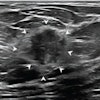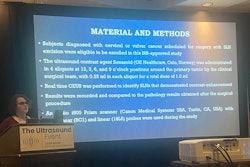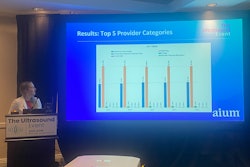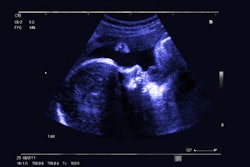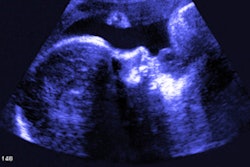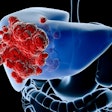ORLANDO – The use of low-dose aspirin during pregnancy is not tied to fetal ductal constriction, suggest findings presented March 30 at the 2025 American Institute of Ultrasound in Medicine (AIUM) annual convention.
In her presentation, Nkechinyelum Ogu, MD, from Northwestern University in Evanston, IL discussed her team’s findings showing that compared to no use, aspirin use among pregnant women is not tied to more severe fetal ductus arteriosus constriction, right ventricular hypertrophy or valvular dysfunction.
“This supports that the use of aspirin for the benefits of reduction of preeclampsia should still be recommended,” Ogu told AuntMinnie.com.
Randomized clinical trials have shown that aspirin can reduce or prevent preeclampsia in pregnant women. Current guidelines by several medical societies recommend that women at risk of developing preeclampsia start on low-dose aspirin at 12 weeks’ gestation, continuing until delivery.
However, some nonsteroidal anti-inflammatory drugs (of which aspirin is a part) can lead to complications such as premature births and premature closure of the ductus arteriosus, an important part of fetal circulation.
Ogu and colleagues studied potential associations between low-dose aspirin use (81 mg) in pregnancy and fetal ductus arteriosus constriction diagnosed on prenatal fetal echocardiography, comparing results to those of pregnant women who did not take aspirin. They also investigated the impact of aspirin use on antenatal ductal constriction on obstetrical and neonatal outcomes.
The team defined ductal constriction as a peak velocity of 140 cm per second (cm/s) or higher, peak diastolic ductal velocity of 30 cm/s or higher, and/or pulsatility index of 2.2 or lower.
Final analysis included data collected between 2020 and 2024 from 104 echocardiography exams from 51 pregnant women. Women on aspirin were more likely to have a body mass index (BMI) greater than 30 (p = 0.002) compared with nonusers.
 Nkechinyelum Ogu, MD, presents her team’s findings showing that aspirin use among pregnant women is not tied to more severe fetal ductus arteriosus constriction and other complications.
Nkechinyelum Ogu, MD, presents her team’s findings showing that aspirin use among pregnant women is not tied to more severe fetal ductus arteriosus constriction and other complications.
Additionally, differences in the end-diastolic velocity (p = 0.67) and pulsatility index (p = 0.69) did not reach statistical significance. The same trends went for the rates of tricuspid regurgitation (p = 0.7), cardiomegaly (p = 0.6), and right ventricular dysfunction (p = 0.9).
Also, 33% of fetuses exposed to aspirin in utero needed neonatal resuscitation compared to 27% of nonexposed fetuses, though this did not achieve statistical significance (p = 0.8). And 46% of neonates exposed to aspirin in utero needed a NICU admission compared with 30% in the nonexposed cohort. Again, this did not achieve statistical significance (p = 0.3).
Finally, the researchers noted that there was no difference in the use of inotropes and prostaglandins.
Ogu said that the team is enrolling patients for a follow-up study comparing the effects of low-dose versus high-dose aspirin in pregnant women.
“Hopefully, we’ll see a reduction in preeclampsia with a higher dose and maybe other benefits as well,” she told AuntMinnie.com.


